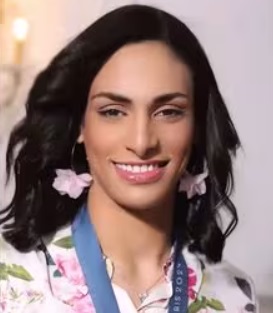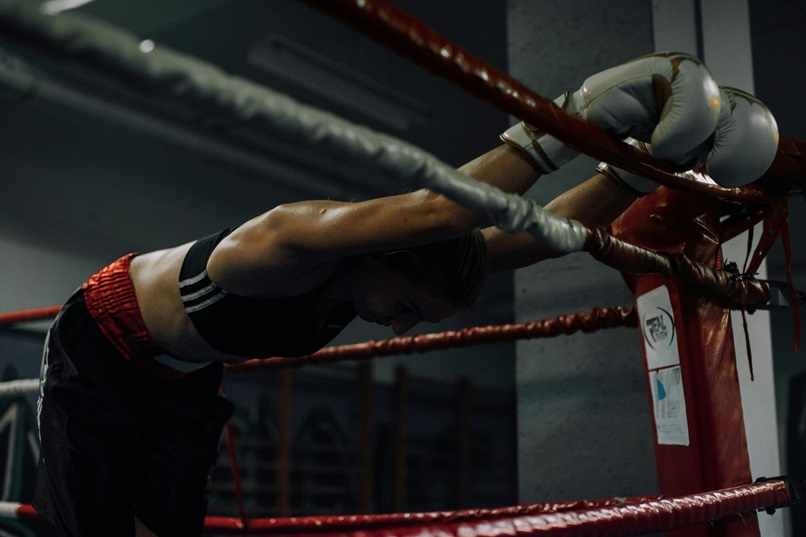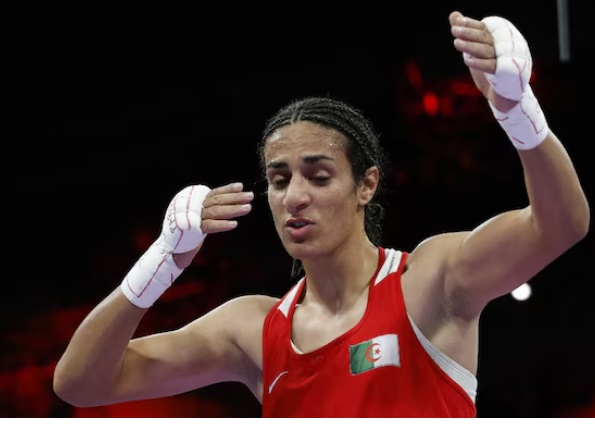Algerian Boxer Imane Khelif
Algerian boxer Imane Khelif captured the world’s attention by clinching the gold medal in women’s boxing at the 2024 Paris Olympics. Hailed as a symbol of resilience, skill, and national pride, Khelif’s success has also reignited complex debates around eligibility in women’s sports. Following a recently leaked medical report, which questions her qualification to compete in female categories, Khelif’s journey stands at the intersection of sports, gender, and ethics, placing her at the center of a highly polarized global conversation.
Who is Imane Khelif?
Born and raised in Algeria, Imane Khelif is no stranger to adversity. From a young age, she demonstrated an extraordinary affinity for boxing, training rigorously and showcasing an innate talent that soon elevated her to national and international levels. As a trailblazer in Algerian women’s boxing, her dedication and accomplishments have inspired many young athletes, particularly in regions where opportunities for female athletes are limited. Her athletic prowess was recognized on a global stage, as she gained acclaim through various championships leading up to her participation in the 2024 Paris Olympics.
Khelif’s performance at the Olympics was exceptional. Her victory not only brought pride to Algeria but also highlighted the growth and potential of North African athletes on the international stage. For many, Khelif’s story was an inspiring narrative of overcoming challenges. However, her achievements have been overshadowed by recent controversies that put her eligibility in question, following a medical report that raises concerns about her genetic profile and anatomical characteristics.
Medical Report and Controversy

The leaked report that brought Khelif into the spotlight was accessed by French journalist Djaffar Ait Aoudia. According to the report, Khelif has an XY chromosome composition typically associated with male development, along with internal testicles, potentially signaling a genetic condition known as 5-alpha reductase deficiency. This condition is characterized by differences in sexual development, which may include ambiguous genitalia and a limited development of secondary male characteristics. In Khelif’s case, it was reported that she possesses no uterus and has what was described as a micropenis.
The leaked report that brought Khelif into the spotlight was accessed by French journalist Djaffar Ait Aoudia. According to the report, Khelif has an XY chromosome composition typically associated with male development, along with internal testicles, potentially signaling a genetic condition known as 5-alpha reductase deficiency. This condition is characterized by differences in sexual development, which may include ambiguous genitalia and a limited development of secondary male characteristics. In Khelif’s case, it was reported that she possesses no uterus and has what was described as a micropenis.
The scrutiny of Khelif’s participation in women’s boxing stems from a broader issue: how sports organizations manage and enforce eligibility based on gender. Many argue that athletes competing in women’s divisions must meet specific criteria to ensure a fair playing field, and for some, Khelif’s condition seems to pose a conflict. While Khelif has consistently identified and lived as a woman, questions regarding physical advantages attributed to her unique genetic composition have sparked renewed debates.
A History of Challenges

This is not the first time Khelif has faced such scrutiny. In 2023, the International Boxing Association (IBA) barred her from competing in the gold medal match at the World Championship in New Delhi. The decision cited concerns regarding her eligibility under the gender-specific regulations of the competition. For many, this decision reflected an increasingly strict stance by sporting bodies on matters of gender eligibility, a stance which is itself under intense public and political pressure.
While Khelif and her supporters argue that her exclusion from the New Delhi championship denied her the opportunity to showcase her talent and hard work, the decision was seen by others as necessary to maintain fairness in women’s boxing. Advocates for strict gender regulations in sports argue that certain physical advantages—stemming from genetic or hormonal factors—could compromise the integrity of female-only categories. Khelif’s exclusion from the championship was a clear indication of the challenges that athletes with differences in sexual development (DSD) may face in competitive sports.
Understanding 5-Alpha Reductase Deficiency

To better understand the debate surrounding Khelif’s eligibility, it’s essential to grasp the nature of 5-alpha reductase deficiency. This condition, caused by a genetic mutation, affects the body’s ability to convert testosterone into dihydrotestosterone (DHT), a hormone crucial for male sexual development. As a result, individuals with this condition may have atypical genitalia at birth and might not develop certain male secondary sexual characteristics, such as increased muscle mass or body hair, during puberty. In many cases, individuals with this condition are assigned female at birth, despite having XY chromosomes and internal male reproductive organs.
In Khelif’s case, the absence of a uterus and the presence of internal testicles were significant findings in the medical report. For some, this raises questions about potential advantages related to muscle development and physical endurance, which are often key factors in sports like boxing. However, the impact of these characteristics on her athletic performance remains difficult to quantify.
The Broader Debate on Gender Eligibility in Sports

Khelif’s case is far from unique in the world of competitive sports. Over the years, high-profile athletes with DSD or intersex traits have faced similar scrutiny, including South African runner Caster Semenya. These athletes often find themselves at the center of intense public debate and sometimes painful personal battles over their right to compete. As more is understood about the wide spectrum of gender and biological diversity, governing bodies like the International Olympic Committee (IOC) and the IBA continue to face immense pressure to define clearer guidelines for eligibility.
One key issue within this debate is whether certain genetic or hormonal traits can give athletes an “unfair” advantage, even when they identify and live as women. Supporters of strict eligibility criteria argue that allowing athletes with higher levels of testosterone or other physiological traits associated with male development in women’s sports categories may create an imbalance in competition. On the other hand, opponents claim that placing restrictions on these athletes is discriminatory and denies them the right to compete based on who they are.
Reactions from Public Figures and Media

The controversy surrounding Khelif has attracted comments from influential public figures. British broadcaster Piers Morgan, known for his strong views on issues related to gender and sports, called for an immediate review of Khelif’s eligibility. He argued that in the interest of fairness, strict guidelines must be applied to uphold the integrity of women’s sports. Similarly, former U.S. President Donald Trump commented on Khelif’s case, using it as an example in his discussions on gender policies in sports.
Media coverage of Khelif’s case has been extensive, with opinions on both sides of the issue. Advocates for Khelif’s right to compete argue that the focus should be on her athletic abilities rather than her genetic makeup, while others express concerns about the potential for competitive imbalance. This coverage reflects the growing complexity of gender-related issues in sports, which is especially pertinent in today’s evolving understanding of gender identity and biology.
The Road Ahead for Khelif and Gender Classifications in Sports
Khelif’s case underscores the need for sports organizations to address the complexities surrounding gender and eligibility criteria. As more athletes with DSD and intersex variations emerge in the competitive arena, a critical conversation must take place to ensure both inclusivity and fairness. The rules around eligibility are likely to continue evolving, with organizations working to balance scientific findings, ethical considerations, and the lived realities of athletes like Khelif.
Khelif’s journey is emblematic of the shifting landscape of sports, where traditional gender classifications are increasingly questioned. As society broadens its understanding of gender diversity, sports governing bodies are tasked with ensuring fair competition while respecting the identities and rights of all athletes. Whether the policies shift toward stricter regulations or more inclusive measures, Khelif’s story highlights the human dimension of these debates.
Disclaimer
This blog discusses the sensitive topic of gender and eligibility in sports, particularly in relation to athletes with differences in sexual development (DSD) and genetic variations. The information presented here is based on available reports and sources, but it does not seek to make any definitive judgments about the individual named or her eligibility. The discussions around gender classification and sports eligibility are complex, involving ethical, biological, and societal dimensions that affect both athletes and the larger sporting community.
The story of Imane Khelif should be understood within the context of her accomplishments and the broader conversations surrounding gender in competitive sports. As with all such discussions, the perspectives and rights of individuals must be respected, acknowledging that they may face considerable personal and professional challenges.
This blog encourages readers to approach the subject with empathy, understanding, and an appreciation for the intricacies of human identity and achievement in sports.

